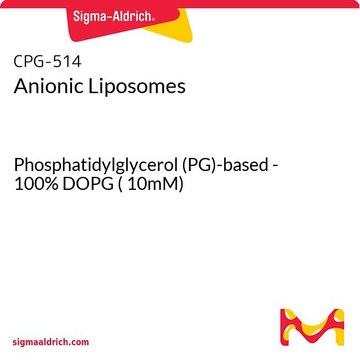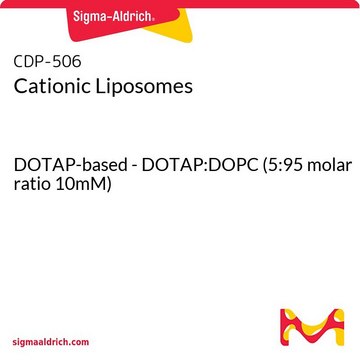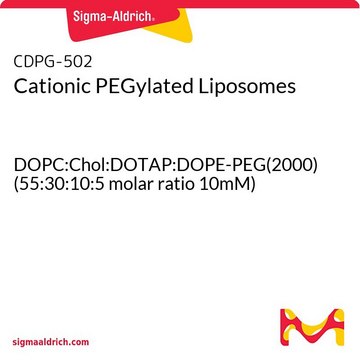CPGG-502
Anionic PEGylated Liposomes
DOPC:Chol:DOPG:DOPE-PEG(2000) (60:30:5:5 molar ratio 10mM)
Iniciar sesiónpara Ver la Fijación de precios por contrato y de la organización
About This Item
UNSPSC Code:
12352211
NACRES:
NA.25
Productos recomendados
Quality Level
composition
Phosphate buffered saline
concentration
10 mM
impurities
30 mol % Cholesterol
5 mol % DOPE-PEG2000
5 mol % DOPG
60 mol % DOPC
particle size
100 nm
pH
7.4
¿Está buscando productos similares? Visita Guía de comparación de productos
General description
Poly(ethylene glycol) (PEG) is commonly added to liposomes to improve stability, hydrophilicity and enhance circulation time. Anionic PEGylated liposomes protect liposomes from circulating proteins, improving their plasma clearance and enhancing their therapeutic effects. In addition, anionic liposomes demonstrate greater stability in solution, lead to lower aggregation when compared to neutral liposomes, and have increased endocytosis when compared with cationic and neutral liposomes.
Application
Drug delivery
Lipid-protein interactions
Lipid-protein interactions
Storage and Stability
Liposomes should never be frozen. Liposomes should be stored in the dark at 4°C, except when brought to room temperature for brief periods prior to use.
Liposomes are made under sterile conditions. If you need to take multiple aliquots out of the vial, it is advised to take extreme care in not contaminating the vial. It is recommended to handle the vial under a sterile hood to maintain the sterility of the product. Liposomes should never be frozen. Ice crystals that form during freezing will rupture the lipid membrane of the liposomes and change the size of liposomes particles.
Liposomes are made under sterile conditions. If you need to take multiple aliquots out of the vial, it is advised to take extreme care in not contaminating the vial. It is recommended to handle the vial under a sterile hood to maintain the sterility of the product. Liposomes should never be frozen. Ice crystals that form during freezing will rupture the lipid membrane of the liposomes and change the size of liposomes particles.
Legal Information
Cellsome is a trademark of Encapsula NanoSciences
Product of Encapsula Nanosciences
Disclaimer
For research use only
Storage Class
12 - Non Combustible Liquids
wgk_germany
WGK 2
flash_point_f
Not applicable
flash_point_c
Not applicable
Certificados de análisis (COA)
Busque Certificados de análisis (COA) introduciendo el número de lote del producto. Los números de lote se encuentran en la etiqueta del producto después de las palabras «Lot» o «Batch»
¿Ya tiene este producto?
Encuentre la documentación para los productos que ha comprado recientemente en la Biblioteca de documentos.
Nuestro equipo de científicos tiene experiencia en todas las áreas de investigación: Ciencias de la vida, Ciencia de los materiales, Síntesis química, Cromatografía, Analítica y muchas otras.
Póngase en contacto con el Servicio técnico





![18:1 Lysyl PG 1,2-dioleoyl-sn-glycero-3-[phospho-rac-(3-lysyl(1-glycerol))] (chloride salt), powder](/deepweb/assets/sigmaaldrich/product/structures/293/926/aa70270a-36be-4732-892e-85966f4dddf1/640/aa70270a-36be-4732-892e-85966f4dddf1.png)


